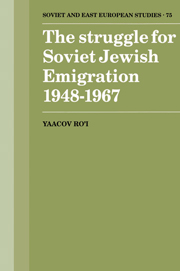2 - Jewish consciousness during the “black years”
Published online by Cambridge University Press: 31 October 2009
Summary
The mood of Soviet Jewry
The trends that characterized the postwar years were intensified during the last years of Stalin's rule and did not for the most part begin to change until his death in March 1953. The economic recovery program began to bear fruit, notably in the spheres of heavy industry and construction: the USSR conducted its first atomic explosion in 1949; a series of hydroelectric stations, canals and irrigation projects were completed, and cities destroyed in the war were rebuilt, monuments not only to bad architectural taste but also to the Kremlin's ambition and drive. The Iron Curtain became virtually impregnable and the camps became filled with prisoners, including large numbers of demobilized soldiers who had served in Eastern or Central Europe in addition to the ex-prisoners-of-war who had been incarcerated upon their return to the Soviet Union. Among others the ever-growing camp population made a significant contribution to the economic momentum.
Although Zhdanov had died in August 1948 and a number of his closest supporters were purged in March 1949 in the Leningrad Affair, the basic tenets of Zhdanov's cultural and ideological policy — which subordinated the arts and sciences to the needs of the state and severely curtailed the scope of minority cultures — continued to dominate the scene.
The enhanced “vigilance” campaign of Stalin's last six months involved economic trials, purges in some of the national republics, a further deterioration in Soviet-U.S. relations (Ambassador George Kennan was declared persona non grata in the USSR), and the Doctors' Plot which was “exposed” in January 1953.
- Type
- Chapter
- Information
- The Struggle for Soviet Jewish Emigration, 1948–1967 , pp. 39 - 54Publisher: Cambridge University PressPrint publication year: 1991



